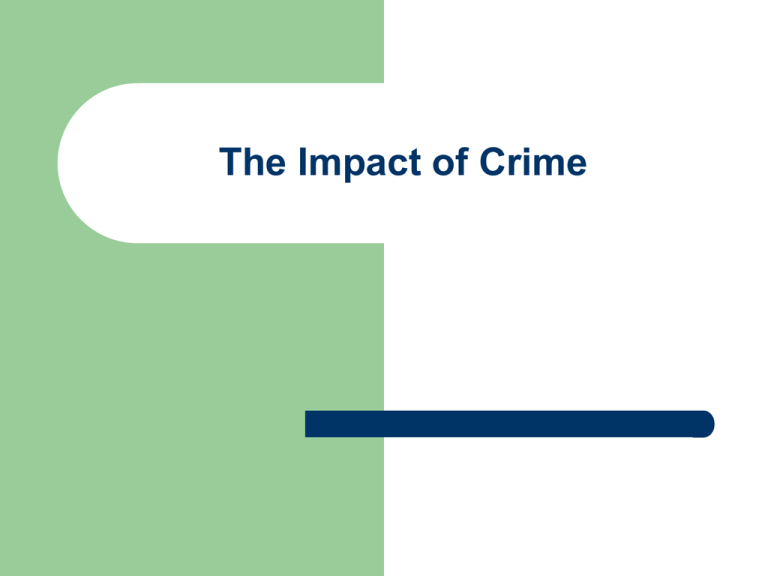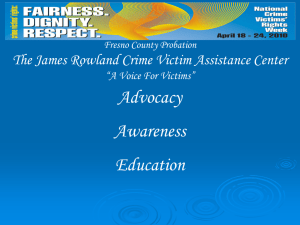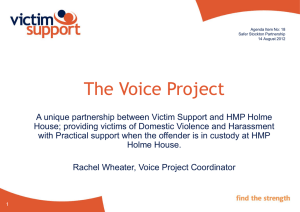The Impact of Crime - Clydebank High School
advertisement

The Impact of Crime How does crime impact on people? The immediate impact – physical harm, loss of / damage to property The ‘aftermath’ (fear of crime) far exceeds the immediate impact: – fewer than one per cent of victims said that their physical injuries were the most upsetting aspect of their experience (Hodgson 2005). How crime impacts on society Encourages people to take expensive security measures (e.g. alarms, taking taxis and cars rather than public transport) Discourages socialising – fear of ‘going out’ Fear of using public spaces Not moving to / going into certain areas Undermines social networks The financial cost The cost of the penal system has to be met from taxation – funding ‘diverted’ from other public services (see ‘costs’ below) Losses due to theft are passed on to customers Insurance premiums increased Cost of treating victims of violence - NHS & Victim Support services Some examples – England and Wales 2009/10 £34 billion - crimes against individuals and households £2 billion - treating victims £4 billion - lost economic output £700 million - property damage Criminal justice costs - £6 billion Victims Support survey The unequal impact of crime - factors Income / social class Area Ethnicity Age Gender Income / social class Repeat victimisation affects poor most - 4% of victims experience 44% of crime (Farrel and Pease 1993) People with incomes of less than £10,000 are: 1.6 times more likely to be mugged – 1.3 times more likely to be burgled – 4.2 times more likely to feel ‘very unsafe’ when walking home alone in the dark Than people with incomes of over £30,000 – Income / social class (cont’d) Better off can afford to: – – – – – Install security measures Live in safer areas Take private transport Pay for insurance policies Able to take other steps to avoid being victims Poor hit hardest and are least likely to be able to cope with the impact – e.g. no insurance Impact on Area Depopulation, particularly in urban areas High levels of crime may damage community spirit and result in less neighbourliness. People may simply want to ‘keep themselves to themselves’ for fear of harassment High crime levels can contribute to ‘environmental poverty’ – vandalism, graffiti Once a region with a high level of crime is labelled as a bad area, it might become a ghetto Impact on Area (contd) Impacts most on people living in the most deprived areas : – – – 2.5 times more likely to be mugged 2.5 times more likely to be burgled 2.6 times more likely to be ‘very worried’ about being attacked People living in urban areas more likely to be victims than people living in rural areas People living in social housing more likely to be victims than people living in private housing (often more than double) Impact on Area (contd) Biggest differences are between very local areas – sometimes even adjacent streets Deprived areas not always high crime areas – e.g. Sedgefield: ex mining area with high % of retired Ethnicity and crime overlap between deprivation and ethnicity (crime more common in deprived areas) Minorities more likely to be victims of crime p- may be because ethnic groups have higher % of young When ‘age’ factor removed, rates are similar for Asians Mixed race most at risk of of assault, robbery, vehicle theft, burglary and vandalism although rates similar, types of crime vary – esp. ‘hate’ crime National Stastics online Ethnicity and crime – victims (%) National Statistics Online Age Young people most likely to be victims 35% children between 10 -15 were victims of crime on 2003 19% experienced 5 or more incidents 59% of children from ‘On Track’ (deprived) areas victims of crime in 2004 25% of boys and 10% of girls were attacked Age (contd) Bullying – black children, ‘looked after’ children and children excluded from school much more likely to be victims 16 – 24 year olds twice as likely to be victims and perpetrators Risk of being victims of crime falls sharply with age Fear of crime impacts more on elderly despite sharp fall in crime experienced with age Significant under reporting of crime against the elderly









